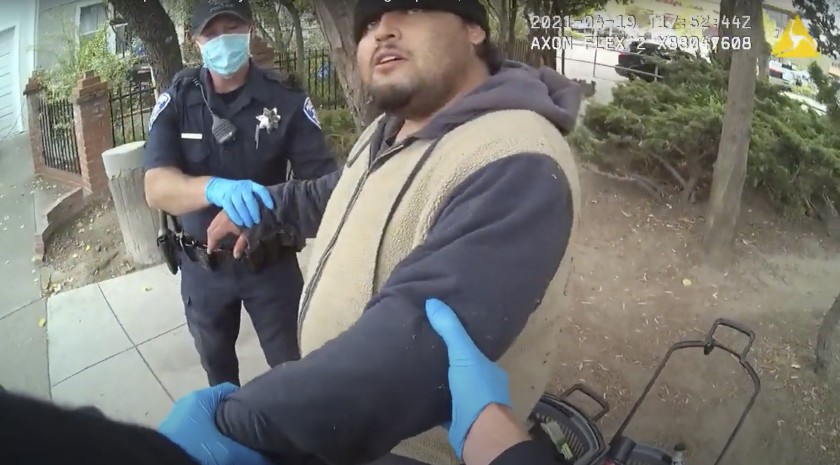Los Angeles Times / Richard Winton, Lila Seidman
In a case drawing comparisons to the killing of George Floyd, authorities in the Bay Area city of Alameda are facing growing outrage after a body-camera video showed a police officer appearing to put a knee on the back of a 26-year-old Latino man for more than four minutes as he gasped for breath and eventually died.
The incident has drawn scrutiny in part because the man who died, Mario Gonzalez, appeared to pose no imminent threat to the officers when they arrived at a local park on April 19 after calls about an intoxicated man and a possible theft.

One of the 911 callers told a dispatcher: “He seems like he’s tweaking. But he’s not doing anything wrong, he’s just scaring my wife.”
A second caller told a dispatcher about a man with a Walgreens basket with alcohol and “it looks like he is breaking off the security tags.” That caller added that the man had been loitering for half an hour.
Some law enforcement experts said the video raises serious questions about police tactics.
“There is going to be a very intensive inquiry on this,” said Ed Obayashi, a Northern California sheriff’s deputy, legal advisor and veteran police trainer. “It is rare that a non-threatening, non-belligerent person ends up dying like this. … What was the officers’ justification for detaining him? This individual was not a threat to the officers.”
The nearly hourlong video from two officers’ body cameras shows police talking to Gonzalez in a park. In the video, Gonzalez seems dazed and struggles to answer officers’ questions.
Gonzalez wouldn’t produce any identification, so the officers try to force his hands behind his back to handcuff him, but he does not let his arms go limp. The officers determine that he is resisting, then push him to the ground, the video shows.
The officers, as they seek to restrain him, repeatedly ask Gonzalez for his full name and birth date.
“I think you just had too much to drink today, OK? That’s all,” an officer says. After learning his name, the officer adds, “Mario, just please stop fighting us.”
Gonzalez, who weighed about 250 pounds, by that point is lying facedown on some wood chips and can be heard shouting and grunting as the officers use their body weight to control him. One officer appears to put an elbow on his neck and a knee on his shoulder.
“He’s lifting my whole body weight up,” an officer tells his colleague.
One officer puts his knee on Gonzalez’s back for four minutes or more.
Gonzalez is heard in the video telling officers, “I didn’t do nothing, OK?”
Shortly before Gonzalez stops breathing, one officer asks the other, “Think we can roll him on his side?” but the other answers, “I don’t want to lose what I got, man.”
Another officer then asks, “We got no weight on his chest?” then repeats, “No! No weight … no weight.”
“He’s going unresponsive,” one officer says.
The officers roll Gonzalez over and perform cardiopulmonary resuscitation, but he was later pronounced dead at a hospital.
The Alameda County coroner’s office is conducting an autopsy to determine a cause of death. Gonzalez’s death is under investigation by the Alameda County Sheriff’s Office and the county district attorney’s office.
The city of Alameda on Wednesday identified the three officers placed on leave during the investigation into Gonzalez’s death as James Fisher, Cameron Leahy and Eric McKinley.
Fisher has been with the department since 2010. Leahy joined the force in 2017, and McKinley in 2018.
The city did not describe each officer’s role in the incident captured on video.
Civilian parking enforcement employee Charlie Clemmens was also involved in the incident, the city said.
Julia Sherwin, an attorney for Gonzalez’s family, said the young man’s death was “completely avoidable.”
She said officers should never have laid hands on him, let alone put him prone on the ground and push down on him — something that law enforcement officers should know creates “a very high risk of death by restraint asphyxiation.”
“It was a complete violation of all generally accepted law enforcement policies and training,” said Sherwin, who has 20 years of experience handling wrongful death cases. “And these horrible tactics employed by the officers on the scene don’t come out of nowhere. They grow out of bad training and supervision.”

Comments are closed.